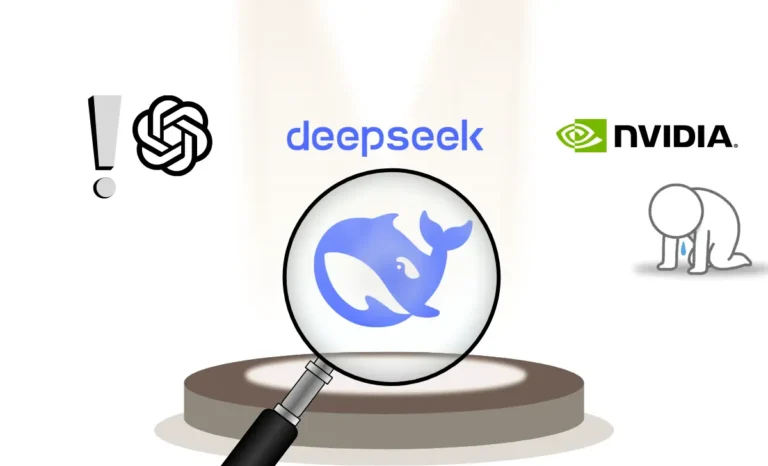Imagine an AI model that costs just a fraction of what leading competitors require—an innovation so groundbreaking that its release alone sent shockwaves through global tech markets, with one major chipmaker witnessing a 17% drop in share value. In the rapidly evolving world of artificial intelligence, such disruptions aren’t just news—they’re a call to action for developers, businesses, and enthusiasts alike.
Over the past few years, AI language models have transformed from simple text generators into sophisticated systems capable of intricate reasoning, creative content generation, and real-time problem-solving. With the stakes higher than ever, understanding the subtle differences between these models is crucial. This article will demystify DeepSeek AI—a cutting-edge, open-source model developed by a visionary Chinese startup—and provide a detailed comparison with established players like ChatGPT. Whether you’re looking to integrate AI into your projects or simply want to stay ahead in the digital landscape, join us as we explore what makes DeepSeek AI a potential game-changer in the industry.
In this article
- 0.1 Background on DeepSeek AI
- 0.2 Core Technology and Architecture of DeepSeek AI
- 0.3 Comparing DeepSeek AI with ChatGPT (and Other Models)
- 1 ChatGPT vs DeepSeek
Background on DeepSeek AI
Company Origin and Mission
DeepSeek AI is a Chinese startup founded in 2023 by Liang Wenfeng and backed by the prominent hedge fund High-Flyer. Born out of a clear need for affordable yet powerful AI solutions, DeepSeek set out with a bold mission: to democratize artificial intelligence. In an era where U.S. chip export restrictions have created significant challenges for many companies, DeepSeek has embraced an open-source philosophy to build cost-effective, high-performance language models. By focusing on efficiency and accessibility, the company aims to make advanced AI tools available to a broader range of developers and businesses—empowering innovation even in resource-constrained environments.
Key Milestones
One of the most notable milestones for DeepSeek AI has been the release of its reasoning model, DeepSeek-R1. This model, designed to excel in tasks such as coding, mathematical problem-solving, and logical reasoning, has rapidly garnered attention across the tech industry.
Its breakthrough performance is underscored by its rapid adoption—most notably, DeepSeek-R1 topped the Apple App Store charts shortly after launch, an achievement that has been widely reported by major news outlets like Reuters and others. This rapid market acceptance not only signals the technical prowess of the DeepSeek team but also highlights the growing global demand for AI systems that are both affordable and powerful.
With a clear focus on bridging the gap caused by international technology restrictions, DeepSeek AI’s early achievements set the stage for a new wave of innovation in open-source AI, challenging established models while offering a viable alternative that is both accessible and efficient.
Core Technology and Architecture of DeepSeek AI
At the heart of DeepSeek AI’s innovation is a robust transformer-based architecture enhanced with a Mixture-of-Experts (MoE) design. Unlike traditional transformer models, which process every token through a uniform set of parameters, the MoE framework intelligently activates only a specialized subset of its parameters for each task. This selective processing not only improves performance on complex tasks but also dramatically reduces computational demands.
From a technical efficiency standpoint, DeepSeek has achieved remarkable cost savings. Detailed technical reports reveal that the company managed to train its models at an estimated cost of around US$6 million—using significantly fewer GPUs compared to many Western counterparts. This resource-efficient approach has proven particularly impressive given the scale of modern language models, which typically require extensive hardware investments and prolonged training periods.
Another key element of DeepSeek’s technology is its advanced reasoning capability. The DeepSeek-R1 model, for instance, incorporates a “chain-of-thought” mechanism that mimics human-like reasoning. This design is particularly tailored for technical tasks such as coding, mathematical problem-solving, and logical analysis. By methodically breaking down problems into smaller, verifiable steps, DeepSeek-R1 delivers precise and concise solutions that are highly valued in developer and research environments.
Equally important is DeepSeek’s commitment to an open-source philosophy. All of its models are released under open licenses, making them fully accessible to developers and researchers. This openness not only fosters community-driven innovation and customization but also encourages transparency—a core tenet in building trust and expertise in the rapidly evolving field of AI.
Comparing DeepSeek AI with ChatGPT (and Other Models)
Overview of ChatGPT
ChatGPT, developed by OpenAI, is one of the most widely recognized language models in the industry. Built on a traditional transformer architecture, ChatGPT has evolved into a commercial product known for its polished, user-friendly interface. It offers an extensive range of features—from chat memory and voice interaction to versatile creative and conversational capabilities—that make it a go-to solution for both enterprise and personal applications.
Key Differences in Architecture and Training
When comparing DeepSeek AI to ChatGPT, several fundamental differences emerge that highlight their distinct design philosophies and intended use cases:
- Architecture:
DeepSeek employs a Mixture-of-Experts (MoE) framework that selectively activates only about 37 billion out of its total 671 billion parameters per token. This contrasts sharply with ChatGPT’s conventional transformer approach, where all parameters are uniformly engaged. - Training Efficiency and Cost:
DeepSeek has achieved remarkable cost efficiency, with training costs reported to be around US$6 million—substantially lower than the over $100 million cost attributed to training models like GPT-4. This efficiency is a direct result of its MoE design, which optimizes resource usage by engaging only the necessary subset of parameters for each task. - Open-Source vs. Closed-Source:
A key distinction lies in their accessibility. DeepSeek’s models are open source, providing developers with the flexibility to customize, modify, and deploy the technology in their own environments. In contrast, ChatGPT is proprietary, offering a commercial API with extensive documentation and support but limited opportunities for customization.
User Experience and Feature Set
The differences in architecture and training also manifest in the overall user experience and feature sets offered by each model:
- DeepSeek AI:
- Focus: Designed for technical precision, DeepSeek excels in tasks that demand rapid problem-solving and structured, efficient responses.
- Interface: Its user interface is more minimalistic, emphasizing functionality over embellishments. While this ensures efficient responses for coding, math, and logic-based queries, it may lack some of the extra features found in more polished conversational tools.
- ChatGPT:
- Focus: ChatGPT provides a richer, more engaging conversational experience. It is versatile, making it suitable for both technical inquiries and creative, open-ended discussions.
- Interface: With features like chat history, voice mode, and advanced customization options, ChatGPT delivers a polished and user-friendly experience that appeals to a broader audience.
Detailed Comparison Table
ChatGPT vs DeepSeek
| CATEGORY | ChatGPT | DeepSeek |
|---|---|---|
| Overview | Developed by OpenAI, based on GPT-3.5 and GPT-4. A general-purpose conversational AI. | Developed by DeepSeek AI, tailored for enterprise-level applications and industry-specific solutions. |
| Architecture & Technology | Built on GPT architecture using transformer-based neural networks. | Uses a hybrid architecture combining NLP, ML, and DL for domain-specific tasks. |
| Training Data & Specialization | Trained on a diverse dataset, suitable for general topics but lacks specialization. | Trained on industry-specific datasets with deep expertise in sectors like finance, healthcare, and logistics. |
| Key Use Cases & Applications | Customer support, content creation, education, personal assistants. | Financial analysis, healthcare, logistics, legal applications. |
| Customization & Adaptability | Limited customization, fine-tunable for some tasks but not deeply specialized. | Highly customizable for industry-specific needs, integrated with enterprise systems. |
| Performance & Accuracy | Great at generating human-like text but can produce inaccurate or irrelevant responses. | High accuracy and relevant responses, especially in specialized domains with structured data. |
| Scalability & Deployment | Scalable for general-purpose tasks across various platforms. | Optimized for large-scale enterprise deployments, integrates with ERP systems. |
| Strengths | Versatile across multiple topics. User-friendly and accessible. Fast development with pre-trained models. | Expertise in specialized industries. Highly accurate responses. Customizable for enterprise needs. |
| Weaknesses | May struggle with technical or domain-specific queries. Can generate incorrect responses. | Complex deployment and integration. Higher development and deployment costs. |
| Ideal For | General-purpose AI tasks. When domain expertise is not critical. Cost-effective, easy deployment. | Specialized industries like finance, healthcare, or logistics. Applications needing high accuracy & domain knowledge. Businesses with the resources for customization. |
| Future Trends | Larger datasets and advanced models like GPT-4. Focus on reducing inaccuracies & enhancing domain-specific features. | Complex deployment and integration. Higher development and deployment costs. |
This comparison underscores that while both DeepSeek AI and ChatGPT are powerful in their own right, they cater to different needs. DeepSeek AI’s cost-effective, open-source approach makes it particularly appealing for technical users who require precision and efficiency. Conversely, ChatGPT’s comprehensive feature set and engaging interface serve a broader audience, offering versatility for creative and conversational tasks.
Use Cases and Applications
Technical Tasks and Research
DeepSeek’s design is optimized for technical precision. Its architecture excels at handling tasks that require rigorous logical reasoning, making it an excellent choice for developers and researchers. For instance, when it comes to code generation, debugging, and mathematical problem-solving, DeepSeek demonstrates an ability to produce precise, concise, and efficient outputs. This capability makes it ideal for technical research and development environments where accuracy and speed are critical. Developers can leverage DeepSeek for rapid prototyping and solving complex algorithmic challenges, while researchers can use it to explore new avenues in natural language processing and computational reasoning.
Creative and Conversational Applications
In contrast, ChatGPT is built with a broader, more versatile focus. Its conventional transformer architecture and polished interface enable it to handle creative tasks exceptionally well. Whether you’re brainstorming ideas, drafting content, or engaging in casual conversation, ChatGPT offers an engaging and interactive experience. The model’s ability to generate context-rich responses makes it a valuable tool for content creators, marketers, and anyone looking for a more fluid and natural conversational partner. Its creative versatility supports tasks ranging from writing stories and essays to providing nuanced explanations on various topics.
Developer Integration
When it comes to integrating AI into applications, the accessibility and flexibility of the API are key factors. DeepSeek offers an OpenAI-compatible API that is open-source, which means developers have the freedom to run the model locally, customize it to fit specific needs, and even contribute to its development. This open-source nature can be especially appealing for startups and organizations that value cost efficiency and the ability to tailor solutions in-house. On the other hand, ChatGPT benefits from a robust, well-documented commercial API provided by OpenAI. This API comes with extensive resources, tutorials, and community support, ensuring a smooth integration process for developers who prefer a ready-made solution with guaranteed performance and scalability.
By considering these use cases—whether for technical tasks, creative projects, or developer integration—it’s clear that both DeepSeek AI and ChatGPT cater to different needs within the digital ecosystem. Choosing the right tool will depend on your specific requirements, be it precision and efficiency or conversational versatility and robust support.
Ethical, Regulatory, and Censorship Considerations
Data Privacy and Censorship
DeepSeek, as a Chinese-based AI startup, operates within the framework of local laws and regulations. This means that its models are designed to comply with government requirements, which can include strict censorship rules on politically sensitive topics and other areas deemed sensitive by Chinese authorities. As a result, when you interact with DeepSeek, you might notice that certain topics—such as discussions about political events or human rights issues—are either moderated or not addressed in detail. This regulatory alignment is integral to its operation and helps ensure the model remains in compliance with local standards.
In contrast, ChatGPT adheres to moderation policies that are based on Western standards. OpenAI has developed its guidelines with an emphasis on balancing free expression with the need to prevent harmful content, but these policies tend to be less restrictive compared to those enforced in China. The differences in censorship and content moderation mean that ChatGPT is generally able to provide a broader range of information, although it also comes with its own safeguards against misinformation and harmful content.
Implications for Global AI Development
These divergent approaches to data privacy and censorship have significant implications for the global AI landscape. For one, they affect market dynamics in measurable ways. For example, the release of DeepSeek’s models—despite their censorship limitations—has had a noticeable impact on investor sentiment, contributing to substantial fluctuations in the stock prices of key tech companies like Nvidia. Such market movements reflect the broader uncertainty and competitive tension between AI models developed under differing regulatory environments.
Moreover, the contrast between open-source, cost-effective models like DeepSeek and the proprietary, well-supported systems like ChatGPT is influencing international competition. On one hand, DeepSeek’s open-source approach can foster innovation by enabling developers worldwide to experiment with and customize its technology. On the other hand, the strict censorship measures embedded in its design might limit its application in regions with different legal and cultural norms. This dichotomy not only affects how companies and developers choose which technology to adopt but also influences strategic decisions on global AI investments and partnerships.
Future Perspectives and Industry Impact
Open-Source Movement and Democratization of AI
DeepSeek’s open-source approach represents a significant step forward in democratizing AI. By releasing its models under open licenses, DeepSeek not only lowers the barriers to entry for startups and individual developers but also encourages a collaborative environment where innovation can flourish. This transparency enables researchers and practitioners from around the world to examine, modify, and build upon DeepSeek’s technology, potentially leading to breakthroughs that a single organization might never achieve alone. In a landscape historically dominated by high-cost, proprietary systems, such openness can spark a broader movement towards more accessible and affordable AI solutions.
Competitive Landscape
The cost-efficient design and open accessibility of DeepSeek’s models are poised to exert pressure on established companies like OpenAI and Nvidia. As these tech giants face competition from models that require a fraction of the investment, they may be compelled to innovate further and streamline their operations to remain competitive. This emerging rivalry could lead to faster advancements in AI technology and, ultimately, a more diverse market offering. Companies with deep pockets might need to reassess their strategies, balancing high-end innovation with the need to deliver cost-effective solutions that appeal to a wider range of users.
Long-Term Market and Ethical Implications
Looking ahead, the shifts introduced by models like DeepSeek could have profound long-term implications for global AI leadership. The rise of cost-effective, open-source alternatives may accelerate the decentralization of AI development, allowing regions outside of the traditional tech hubs to contribute more significantly to the evolution of the field. However, these changes also bring ethical debates to the forefront—particularly regarding data usage and censorship. As different regulatory frameworks shape AI outputs, questions about fairness, transparency, and accountability will become increasingly important. Stakeholders will need to balance the benefits of widespread access with the risks of uneven regulation and potential misuse, setting the stage for ongoing discussions about the ethical use of AI on a global scale.
Recap of Key Differences and Benefits
In summary, DeepSeek distinguishes itself with its technical efficiency, open-source framework, and specialized reasoning capabilities. Its innovative Mixture-of-Experts architecture allows it to activate only the necessary parameters for each task, resulting in significantly lower training costs and a highly resource-efficient model. This technical approach makes DeepSeek particularly adept at handling structured, logic-intensive tasks such as coding and mathematical problem-solving. In contrast, ChatGPT offers a broader and more polished user experience. With its comprehensive feature set—ranging from a refined conversational interface and chat memory to voice interaction—ChatGPT is designed for versatility and creative dialogue, making it an excellent tool for both professional and casual use.
Final Thoughts
Choosing between DeepSeek and ChatGPT ultimately depends on your specific needs. If you are a developer or researcher looking for an AI model that excels in technical precision and offers the flexibility of open-source customization, DeepSeek is a compelling option. On the other hand, if you require a more versatile and user-friendly conversational assistant for creative tasks, content creation, or broad-spectrum research, ChatGPT’s commercial polish and extensive support resources might be the better choice. As the AI landscape continues to evolve, both models offer unique strengths that can be leveraged in different projects. I encourage you to consider both options in your own work, experiment with their capabilities, and determine which tool aligns best with your goals and use cases.
Additional Resources and References
Further Reading
For those interested in exploring DeepSeek AI further, here are some key resources and authoritative references:
- DeepSeek Official Website:
Visit DeepSeek.com for an overview of their mission, product releases, and company updates. - GitHub Repository:
Access the source code, technical documentation, and updates on DeepSeek’s projects at their GitHub page. - Research Papers and Technical Reports:
- DeepSeek-V3 Technical Report – A comprehensive report detailing the architecture and training methodology of DeepSeek-V3.
- DeepSeek-V2: A Strong, Economical, and Efficient Mixture-of-Experts Language Model – An academic paper providing insights into DeepSeek’s cost-effective and efficient training strategies.
- Authoritative News and Analysis:
- Reuters: Read the article “What is DeepSeek? Why China’s latest AI model is spooking Wall Street and Silicon Valley” for a detailed market perspective.
- Wired: Check out “Hands On With DeepSeek’s R1 Chatbot” for an in-depth review of DeepSeek’s performance in comparison to ChatGPT.




